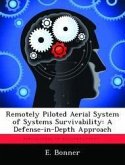This thesis explores the strategic impact of human systems integration (HSI) developments on Remotely Piloted Aircraft (RPA) technology to increase autonomy. A focus on HSI reveals strategic considerations to rethink the use of the Air Force's preferred organizational construct for the acquisitions. Considering the working relationship of the RPA community as it exists today, and identifying the potential drivers of increasing autonomy, provide for an alternate acquisitions model. Specifically, anticipated strategy motivates a technological development sequences towards two thrusts of effort. The first pertains to technologies that enhance platform-centric RPA autonomy. These innovations facilitate the ability of an individual machine to self-monitor critical functions and to devise its own missions. The second thrust encompasses the technologies that will enable a platform to contribute to RPA network objectives.
Bitte wählen Sie Ihr Anliegen aus.
Rechnungen
Retourenschein anfordern
Bestellstatus
Storno








